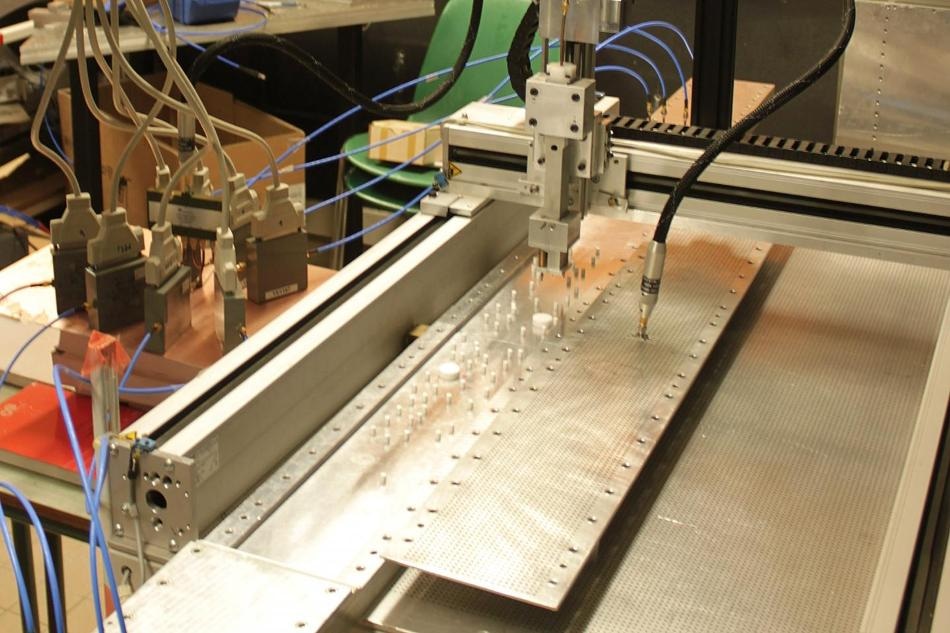Mar 5 2019
The laser is the flawless light source: subject to the provision of energy, it produces light of a specific, distinct color. However, it is also possible to develop the opposite—an object that impeccably absorbs light of a specific color and disperses the energy almost totally.
 Experimental setup of the random anti-laser: a waveguide contains a disordered medium consisting of a set of randomly placed Teflon cylinders, at which incoming microwave signals are scattered in a complex manner. (Image credit - TU Wien)
Experimental setup of the random anti-laser: a waveguide contains a disordered medium consisting of a set of randomly placed Teflon cylinders, at which incoming microwave signals are scattered in a complex manner. (Image credit - TU Wien)
At TU Wien (Vienna), a technique has currently been formulated to make use of this effect, even in very complex systems in which light waves are haphazardly dispersed in all directions. The technique was developed in Vienna with the aid of computer simulations, and verified by experiments together with the University of Nice. This paves way to new possibilities for all technical domains that deal wave phenomena. The new technique has currently been described in the journal Nature.
Random structures that absorb waves
Every day we are dealing with waves that are scattered in a complicated way—think about a mobile phone signal that is reflected several times before it reaches your cell phone. The so-called random lasers make use of this multiple scattering. Such exotic lasers have a complicated, random internal structure and radiate a very specific, individual light pattern when supplied with energy.
Stefan Rotter, Professor, Institute for Theoretical Physics, TU Vienna.
Rotter’s team, using mathematical calculations and computer simulations, could demonstrate that this process can also be reversed in time. Rather than a light source that releases a specific wave based on its random inner structure, it is also possible to construct the ideal absorber, which totally dissipates one particular kind of wave, based on its characteristic internal structure, without allowing any part of it to escape. This can be visualized like making a movie of a standard laser emitting laser light, and playing it in reverse.
Because of this time-reversal analogy to a laser, this type of absorber is called an anti-laser. So far, such anti-lasers have only been realized in one-dimensional structures, which are hit by laser light from opposite sides. Our approach is much more general. We were able to show that even arbitrarily complicated structures in two or three dimensions can perfectly absorb a specially tailored wave. That way, the concept can be used for a wide range of applications.
Stefan Rotter, Professor, Institute for Theoretical Physics, TU Vienna.
The perfect wave absorber
The key result of the study project: For every object that absorbs waves adequately strongly, a specific wave form can be discovered, which is flawlessly absorbed by this object. "However, it would be wrong to imagine that the absorber just has to be made strong enough so that it simply swallows every incoming wave," says Stefan Rotter. "Instead, there is a complex scattering process in which the incident wave splits into many partial waves, which then overlap and interfere with each other in such a way that none of the partial waves can get out at the end." A weak absorber in the anti-laser is sufficient—for instance, a basic antenna capturing the energy of electromagnetic waves.
To test their calculations, the team partnered with the University of Nice. Kevin Pichler, the first author of the Nature publication, who is presently working on his dissertation in the team of Stefan Rotter, spent a number of weeks with Prof. Ulrich Kuhl at the University of Nice to convert the theory into practice using microwave experiment. "Actually, it is a bit unusual for a theorist to perform the experiment," says Kevin Pichler. "For me, however, it was particularly exciting to be able to work on all aspects of this project, from the theoretical concept to its implementation in the laboratory."
The laboratory-constructed "Random Anti-Laser" includes a microwave chamber with a principal absorbing antenna, surrounded by casually arranged Teflon cylinders. Like stones in a pool of water, at which water waves are deflected and reflected, these cylinders can disperse microwaves and form a complicated wave pattern.
"First we send microwaves from outside through the system and measure how exactly they come back," explains Kevin Pichler. "Knowing this, the inner structure of the random device can be fully characterized. Then it is possible to calculate the wave that is completely swallowed by the central antenna at the right absorption strength. In fact, when implementing this protocol in the experiment, we find an absorption of approximately 99.8% of the incident signal."
Anti-laser technology is still in its preliminary stage, but it is easy to visualize potential uses.
Imagine, for example, that you could adjust a cell phone signal exactly the right way, so that it is perfectly absorbed by the antenna in your cell phone. Also in medicine, we often deal with the task of transporting wave energy to a very specific point - such as shock waves shattering a kidney stone.
Stefan Rotter, Professor, Institute for Theoretical Physics, TU Vienna.